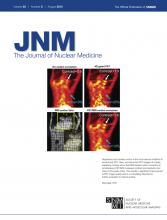TO THE EDITOR: We are thankful for the interesting and highly relevant article by Douglas Van Nostrand and colleagues, published in the March 2012 issue (1). The objective of this study was to compare administration of recombinant human thyroid-stimulating hormone (rhTSH) versus thyroid hormone withdrawal for the identification of metastasis in differentiated thyroid cancer (DTC) on 131I planar whole-body imaging and 124I PET. The authors observed that 131I planar whole-body scans and 124I PET scans identified significantly more foci of metastasis in patients after preparation with thyroid hormone withdrawal than with rhTSH injections. The conclusion drawn by the authors that “physicians should be cautious in using rhTSH for patient preparation before diagnostic scanning for the detection of DTC or treating distant metastasis secondary to DTC with 131I” appears well founded on the data presented. Furthermore, such a study is important, because recently there has been a shift toward the use of rhTSH in increasing numbers of indications in patients with DTC.
However, we have several concerns regarding the authors’ conclusion that “the use of rhTSH is appropriate for patients…[to] increase their endogenous TSH because their metastases are producing significant thyroid hormone.” First, none of the patients in the evaluated study cohort was identified as a patient with thyroid hormone–secreting metastasis. Second, there is no corresponding discussion to support this conclusion. Furthermore, DTC with thyroid hormone–secreting metastases is exceedingly rare. Only a few cases have been reported since the first patient with adenocarcinoma of the thyroid with thyroid hormone–secreting metastasis and postoperative thyrotoxicosis was described by Leiter et al. in 1946 (2). Because of the small number of cases reported so far, patients with hormone-producing metastasis represent a challenge for the further treatment of DTC. Recently, we reported the case of a patient with thyroid hormone–secreting metastasis leading to persistent TSH suppression after thyroidectomy and radioiodine remnant ablation. As suggested by Van Nostrand et al., we assumed that rhTSH was the appropriate preparation to elevate the TSH level before 131I whole-body imaging. However, we observed that when applied before the second radioiodine treatment, rhTSH increased the 131I uptake into the thyroid hormone–secreting metastasis and prolonged the effective half-life of 131I in relation to measurements from the first radioiodine therapy without rhTSH (3). Compared with the original therapy without rhTSH, the 131I uptake after rhTSH increased from 8.4% to 39% and the effective half-life increased from 2.2 to 4.1 d. Subsequent radiation exposure caused bone marrow toxicity with myelosuppression. To prevent grade IV neutropenia, the patient was successfully treated with pegfilgrastim, a long-acting granulocyte-stimulating growth factor.
On the basis of the data presented by van Nostrand et al. and our own experience, we cannot agree with their recommendation regarding the use of rhTSH in the subgroup of patients with thyroid hormone–secreting metastasis. We would propose adding the following clarifications to the article: rhTSH might not be necessary for diagnostic 131I whole-body imaging in patients with TSH suppression due to thyroid hormone–secreting metastasis, because thyroid hormone–secreting metastases generally show a high 131I uptake. Furthermore, in patients undergoing 131I treatment, the use of rhTSH needs to be handled carefully as it can increase 131I uptake and prolong the effective half-life of 131I, leading to an increased exposure to radiation and bone marrow toxicity. Because this subgroup of patients is extremely rare, further studies regarding their optimal diagnostic work-up and treatment should be performed before any general recommendation is given.
Footnotes
Published online Jun. 1, 2012.
- © 2012 by the Society of Nuclear Medicine and Molecular Imaging, Inc.







